
MUSIC
Bach Cello Suite – Part 1 ★★★★
Melbourne Recital Centre, September 24
Some things never go out of style. Since their rediscovery early last century by the famous Catalan cellist Pablo Casals, Bach’s suites for solo cello have held their allure. Witness the capacity audience that packed Melbourne Recital Centre’s Salon to hear three of Australia’s finest cellists play three of the six suites, with a second instalment promised for early next year.
Loading
Featuring the first, fourth and final suites, this program gave an instructive overview of Bach’s compositional processes, demonstrating a variety of approaches to performing these unique and challenging masterpieces.
Melbourne Symphony Orchestra’s principal cello, David Berlin invested the famous Prelude of Suite No.1 with both grandeur and flexibility, before moving on to give well-shaped accounts of the succeeding dance movements. A sprightly gigue, full of rustic enthusiasm, gave the suite a rousing conclusion.
Rising star Richard Narroway delivered an insightful reading of the lesser-known Suite No.4, cast in the unusual key of E-flat major. Here, the encounter between bow and strings was consistently purposeful. Laden with adventurous harmonic and melodic twists, the Prelude signals considerable advances in Bach’s musical thinking. Narroway held the audience transfixed during the contemplative Sarabande, surrounding it with well-pointed contrasts, supported by creative articulation, phrasing and dynamic contrasts.
Having heard two suites performed on conventional instruments, Josephine Vains brought a very different soundworld to Suite No.6 by using a five-stringed baroque cello. Drawing out the florid and rhapsodic elements of the music, Vains imbued the well-known Gavotte with abundant rhythmic flair, but also gave the Allemande a profoundly meditative quality.
These strong but varied performances paid homage to the breadth and depth of musical material to be found in these suites. They will certainly still be stylish when the second half of this journey arrives in 2025.
Reviewed by Tony Way
MUSIC
Belinda Carlisle | Decades Tour ★★★★
Palais Theatre, Sepember 20
Belinda Carlisle arrives on stage barefoot, her silvery skirt shimmering under the blue stage lights. As she claps her hands above her head, the crowd, shyly at first, responds by doing the same.
The American singer’s return to Australia has been much-awaited, with her tour being postponed four times, initially due to COVID and then again in November 2023 due to her knee surgery.
Carlisle’s Decades tour is a celebration of her 35-year solo career after initially finding fame as the lead singer of 1970s all-female rock band, The Go-Go’s. Currently touring Australia, Melbourne’s Friday night show was announced after selling out Saturday’s gig.
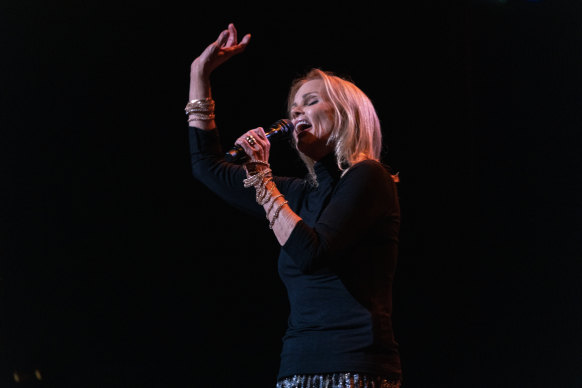
Belinda Carlisle performs at the Palais Theatre in Melbourne on September 20.Credit: Richard Clifford
The performer’s injury doesn’t hold her back as she sways and spins across the stage. She grabs her jingle ring off the standing mic, hitting it against her palm and body as she moves.
Between songs, Carlisle candidly relays an anecdote about how a conversation at a party led to the formation of The Go-Go’s.
“We decided to start a band because all our friends were in bands and they were horrible. So, we thought, we could be in a band and be horrible too,” she admits as the crowd laughs.
“We came here to promote our first single … people thought it was called ‘Alex the Seal’,” she jokes before performing Our Lips Are Sealed. At this point, the audience, which had largely remained in their seats bar a few carefree, enthusiastic fans, launches to their feet to dance.
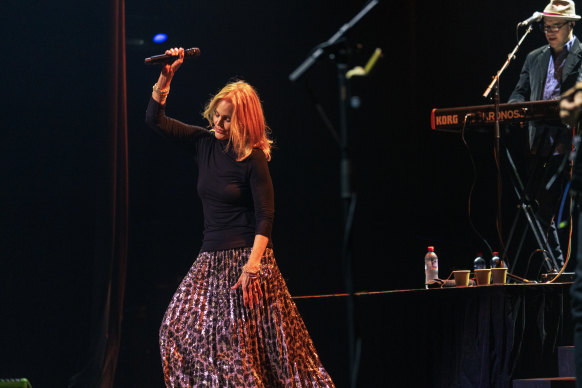
Belinda Carlisle’s Decades tour is a celebration of her 35-year solo career.Credit: Richard Clifford
By the time Heaven is a Place on Earth comes around, the crowd cannot be restrained to their chairs any longer, spilling into the aisles while singing and bopping along. She starts the song off acoustically as if to perform a pared back rendition, before the rest of the band joins in for full effect.
Summer Rain, which Carlisle states is her favourite recorded song, gets the largest cheer. She waves to the crowd as she sings “see my baby waving from the train”.
Loading
By the end of the show, the venue has transformed into a retro dance floor, with the singer ending on her 1991 hit, Live Your Life Be Free, illuminated under an orange stage light.
Leaving the lights on to receive the crowd’s adulation, she raises the jingle ring above her head one last time before exiting the stage.
Reviewed by Vyshnavee Wijekumar
THEATRE
Cost of Living ★★★★★
By Martyna Majok, Melbourne Theatre Company, until October 19
It’s hardly parochial flag-waving to say that Martyna Majok’s Pulitzer Prize winning play Cost of Living would have been impossible without Australia becoming the epicentre of an artistic revolution, led by ensembles of performers with and without disability.
Such companies have refreshed theatre’s great paradox – which, as Back to Back’s Multiple Bad Things recently reminded us, is that formal unreality can get us closer to consciousness of reality itself. Not through “suspension of disbelief”, but its opposite.
Although this play’s a classical four-hander, Anthea Williams’ transcendent production mainstreams the subversion, inviting you to cast aside whatever you believe you know about disability, about privilege and inequality, and much besides. It considers what it means to be human, framing what’s always already a social question at the intimate, precise yet mysterious level of being.
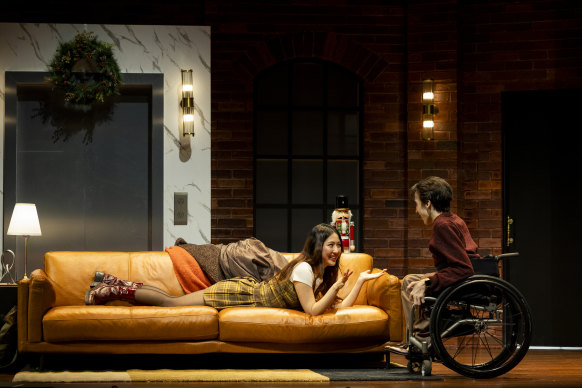
The chemistry between Mabel Li and Oli Pizzey Stratford is moody and intricate.Credit: Pia Johnson
One essential answer, provided by unemployed truck driver Eddie (Aaron Pedersen), is that to be human is to need other people.
Eddie’s need spills out of him as compulsively as the shreds of paper he worries loose from his pocket. Grief, jonesing for alcohol, desperate loneliness – all are pitched at awe-inspiring magnitude, even as they bare the soul of a working-class poet philosopher.
His estranged wife Ani (Rachel Edmonds) reveals another perspective on need. Rendered quadriplegic after a spinal cord injury, Ani embodies a compressed magnetism.
Emotions leap like quicksilver across Ani’s face – spikiness, resentment, stoicism, a determination to assert independence, to quarantine the effect of her disability, and any pity it might inspire, from an intimacy she feels helpless to resist. The scene in which she’s bathed by Eddie portrays a deeply moving connection, and terrifying vulnerability.
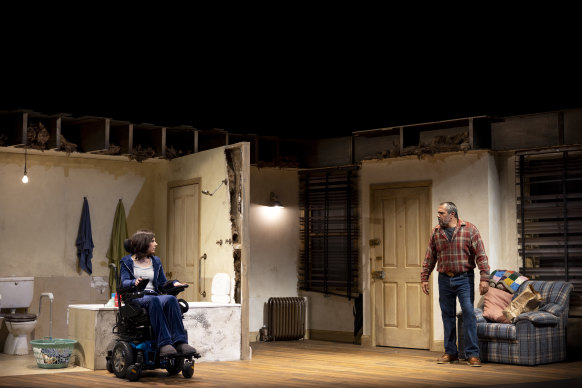
Rachel Edmonds and Aaron Pedersen play characters with a deeply moving connection.Credit: Pia Johnson
This mismatched couple finds its counterpoint in John (Oli Pizzey Stratford) – a young, ultrarich postgrad with cerebral palsy who can afford to hand-pick his carers, and Chinese American bartender Jess (Mabel Li), who needs a side hustle.
Jess will perform ablutions for John, too, as part of an arc which dramatically exposes the subjectivity of intimacy, the way money and choice, trust and desire, influence whether a relationship is transactional or not.
The chemistry between Li and Stratford is moody and intricate. Jess is at once reluctantly exploitative and herself marginalised. As “a net” for her family in China, she faces a cost-of-loving crisis, while John’s arrogance and entitlement and naivety about what poverty means complicate daunting challenges faced in his daily life.
All four performances boast precise and present characterisation – often with a complex tragicomic gloss – leaving enough unsaid to postpone definitive judgement. They’re human beings, being human, and the more you think about them, the more you’ll wonder.
Matilda Woodroofe’s design is monumental and impressively carves out spaces – as psychological as they are architectural – between haves and have-nots, with Richard Vabre and Jethro Woodward using light and sound, respectively, to augment the performances’ emotional charge.
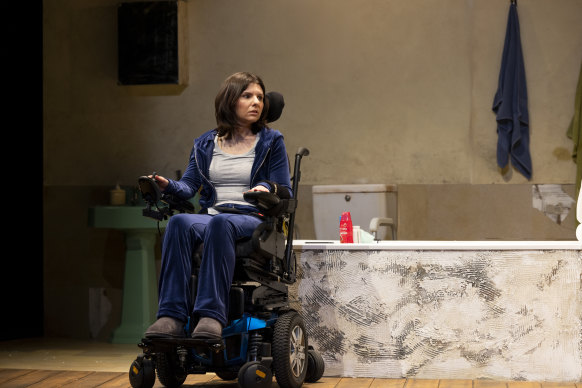
Rachel Edmonds plays Ani in the MTC production of Cost of Living.Credit: Pia Johnson
On opening night, the revolving stage malfunctioned halfway through, and we talked among ourselves for a few minutes until the show resumed. It was a neat illustration of what being an audience is – that quality of being present that great theatre inspires – but it also accentuated Williams’ magisterial sense of time, in a world-class production that will leave theatregoers humbled at its power.
Reviewed by Cameron Woodhead
DANCE
Dredge ★★
Femmural, Theatre Works, until September 28
Creating a full-length dance-theatre piece on broad social themes is a daring and risky endeavour because it must suggest familiar images while transforming them into something fresh and arresting. Striking the right balance between the representational and imaginative while avoiding commonplace expressions of distress is notoriously difficult.
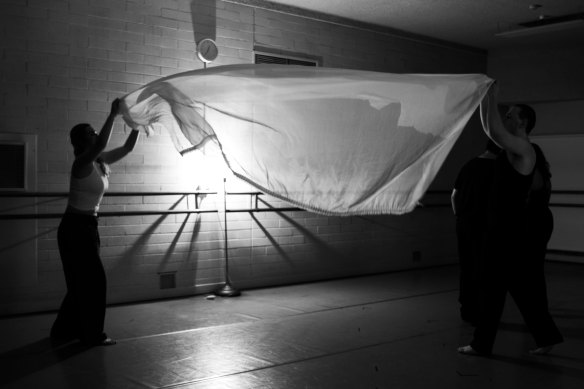
A rehearsal image from Dredge. Credit: Iz Zettl
So Femmural Productions, with a troupe of recent graduates from the National Drama School in St Kilda, must be credited for their courage. Dredge is an ambitious study of the meanness and decadence of modern life. It’s directed by Brandon Armstrong and led by producer and stand-out performer Rosa Ablett-Johnstone.
The work features a prominent blocky structure which holds a sort of bath or fountain full of dirty water. It seems as if the very wellspring of the times has become muddied. The chorus of seven performers shuffles about this corrupted source, performing obscure rites, which periodically transform into fragmentary scenes of everyday life: dating, working and socialising.
The ensemble members bring buckets of enthusiasm, which compensates a little for their technical limitations. Femmural is both earnest and raucous; they have confidence and they have energy. When they throw themselves into the fountain of mud, spectators in the front row can be seen ducking for cover. There is as much drenching as there is dredging.
Loading
This enthusiasm drives the show to its climax, where the dancers literally tear at the curtains in a moment of exaggerated angst. The scene feels overextended with a diluted impact. Dredge, I think, might benefit from a shorter format, perhaps presented alongside other works with contrasting emotional textures.
The dismal tone of this prolonged meditation is not entirely dispelled by the finale, which – despite a brighter presentation – has a distinctly funereal quality, with winding sheets and tears from heaven: ah, yes, what a terrible mess we’ve made.
Reviewed by Andrew Fuhrmann
The Booklist is a weekly newsletter for book lovers from Jason Steger. Get it every Friday.









 Add Category
Add Category